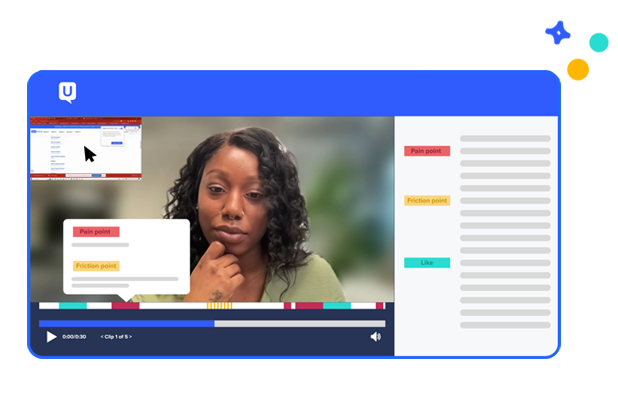
11 product discovery techniques to help your team succeed

Product discovery is an essential phase in the product development cycle that allows you to understand your customers' needs and preferences.
But how does a product team conduct a successful product discovery process? What core techniques and approaches should they use? Let's address these questions with a list of 11 product discovery techniques to help any product team be successful.
What is product discovery?
Typically conducted prior to development, product discovery is the process of identifying, defining, and validating innovative ideas for new products or enhancing existing ones. The process involves cross-functional teams that include product managers, designers, engineers, and other stakeholders. Ideally, during product discovery, the team should engage with test users to gather insights and understand their needs.
Through methods such as user interviews, surveys, and market research, you can uncover pain points and opportunities. As an iterative approach, product discovery encourages continuously prototyping and testing to validate assumptions and ideas quickly. By working closely with real users and involving them in the development process, product discovery maximizes your chances of creating valuable and successful products that align with market demands, user expectations, and organizational goals.
Quantitative and qualitative data
Before we begin listing product discovery techniques, it's necessary to point out that both quantitative and qualitative data play pivotal roles in product discovery.
Quantitative data includes measurable and numerical information, such as usage metrics, conversion rates, and survey responses with predefined choices. It helps product teams to identify patterns and trends, allowing them to make data-informed decisions. For example, analyzing user engagement metrics can reveal which features are most popular or where users tend to drop off, informing feature prioritization.
Qualitative data, on the other hand, consists of non-numerical insights like user feedback, interviews, and observations. It provides a deeper understanding of your customers' behavior, motivations, and pain points. Qualitative data can help product teams uncover the why behind the quantitative metrics. User interviews, for instance, can reveal the specific challenges people face and their emotional reactions to a product.
In the product discovery process, both types of data are equally important. Quantitative data informs teams about the scope and magnitude of issues or opportunities, while qualitative data adds context and helps generate hypotheses and ideas. By conducting a balanced discovery that incorporates quantitative and qualitative insights, product teams can make informed, user-centric decisions throughout the discovery process.
Core product discovery techniques
To help you start implementing your product discover process, here are 11 of the core techniques that every team should take advantage of.
1. Frame the problem
Clearly defining the problem or opportunity your product will address is a vital part of product discovery. This involves engaging with stakeholders and team members to gain a comprehensive understanding of the issue. Your team should outline the issue's scope and impact, describing the problem clearly and concisely. This is a called a "problem statement."
Creating a problem statement helps get everyone involved on the same page and clearly defines the problem at hand, both of which set the stage for effective problem-solving.
2. User research
Engaging with real users through methods like interviews and surveys helps you understand the most pressing pain points to solve with your product. User research is about proactively seeking an understanding of their needs and behaviors in order to uncover insights and spur ideation. Asking users or target audiences the right product discovery questions enables the team to understand its audience, uncover valuable insights, and craft a product that addresses real-world user problems.
3. Competitive analysis
Study the market to identify trends, competition, and opportunities. By gathering data on industry developments and analyzing competitors, your team can accurately position your product within the market, make informed decisions, and strategically differentiate from competitors' offerings. When doing competitive analysis, many teams will actually run usability tests on competitor's products to see what features and functionalities are weak or cause friction for users. This helps the team understand opportunities for improvements to their own design.
4. Brainstorming
To brainstorm, team members work together to generate a wide array of creative ideas and solutions. There are plenty of approaches or methodologies to brainstorming. Oftentimes, teams will set a timer and write down as many solutions to the problem statement as they can, then collectively vote on the solutions that emerge. The team may then take time to each individually sketch out what the selected solutions look like in their minds and present their work to everyone else before another round of voting. As the brainstorm goes on, you and your team can get closer and closer to a first direction you all agree upon.
5. Prototype testing
Creating low-fidelity prototypes or minimum viable products (MVPs) is the first step in validating your concepts with real users. During this stage, your team creates an interactive version of the product or experience you have in mind. The goal is to users react to something tangible so that you can know whether the idea is heading in the right direction. This mitigates the risk of investing heavily in a solution that may not meet user needs.
Users can engage with the prototype through usability testing, A/B testing, user interviews, and more. Involving users early in the testing process will allow your team to refine designs and concepts, demonstrating a customer-centric focus.
6. Iterative research and design
The team should take a continuous and active approach to analyzing the quantitative and qualitative data they gather from customer feedback and validation. Look for patterns, trends, and insights that will inform the decision-making process and necessary product refinements. Formulate clear hypotheses based on data and test them with experiments so your team can validate assumptions and make data-informed decisions.
A culture of continuous discovery drives iteration based on user feedback and data analysis, ensuring that the product continues to evolve to meet user needs and line up with organizational objectives.
Unique approaches to product discovery
At this point, you may be wondering how to use the above techniques to set your organization apart from competitors and create truly innovative, user-centered designs. During the product discovery process, thinking outside the box while engaging various unusual techniques and perspectives can foster relevant, user-centered solutions. In addition to the core techniques we discussed above, here are 10 additional product discovery methods and strategies you can use to get creative.
1. Jobs-to-be-done (JTBD)
Instead of focusing on traditional demographics, the jobs-to-be-done (JTBD) framework identifies the job or functional task that users will try to accomplish with your service. Gaining a better understanding of why customers use your product prepares design teams to create solutions that directly address these needs.
2. Innovation games
Innovation games are a form of qualitative marketing research in which participants play directed games as a way to generate feedback about a product or feature. These structured games engage cross-functional teams in collaborative brainstorming. Games such as "Buy a Feature" or "Product Box" encourage participants to prioritize features or envision a product's packaging. This kind of active involvement can spark creativity and guide consensus on product direction.
3. Design thinking workshops
Involving interdisciplinary teams in design thinking workshops helps them focus on empathy, ideation, and prototyping. Your team members can offer their diverse perspectives while exploring design theories to foster creative problem-solving and a better understanding of user needs.
4. Customer journey mapping
With customer journey mapping, your team lays out the entire user journey from awareness to post-purchase. This approach visualizes touchpoints and pain points, allowing teams to be proactive about identifying opportunities for improvement and innovation.
5. Ethnographic studies
Teams can gain deep insight into users' behaviors, needs, and pain points by observing users in their natural environment. This is called an ethnographic study, which captures unspoken user preferences and guides product development with rich, firsthand data.
Product discovery with UserTesting
By incorporating these techniques and methodologies, product teams can fuel creativity, encourage a deeper understanding of user needs, and foster innovation in their product discovery processes. Each approach brings its own benefits and has its own relevant time or place. You should tailor these techniques to suit your specific users' needs, product requirements, and goals.
We empower product teams to thrive in their product discovery processes. Through our human insight platform, teams can engage with a massive pool of real users and gather actionable insights that can inform product development decisions. You can test designs, prototypes, and concepts with a diverse participant base. Resulting insights help you proactively and iteratively refine your ideas to align with user needs.

Get actionable insights today
Uncover human insights that make an impact. Book a meeting with our Sales team today to learn more.





